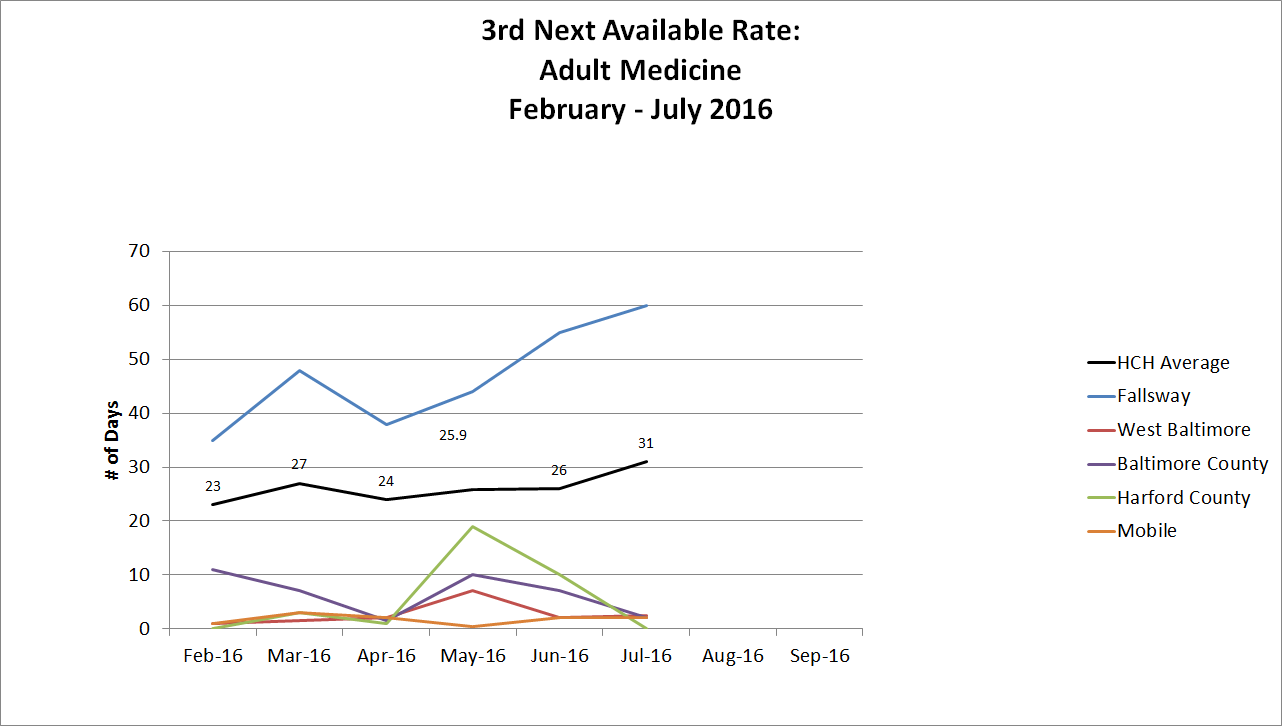Client Access to Care

We know how we're doing by measuring:
- the quality of care we deliver to clients
- client access to that care
Access
Access is the ability to get the right care at the right time. Access to care here at Health Care for the Homeless is about matching our providers' availability with our clients' needs. And assessing our availability shows us how accessible we are to our clients.
We assess our availability by measuring:
- our no-show rate
- our walk-in rate
- our utilization rate
We determine whether our availability matches our clients’ needs by measuring:
- our 3rd next available appointment rate
We track these four access rates monthly, for all of our clinic sites, across all of our areas of care. And each month we highlight one of them, within a particular area of care, to take a deeper look into our clients' access to care, and to use that information to continuously do better.
For a full report—of each access rate for each area of care—click here.
HIGHLIGHT: 3rd Next Available Appointments (February 2016 - July 2016)

The above chart shows the 3rd next available appointment rates for adult medicine at each of our clinic sites. We also currently track 3rd next available rates for behavioral health and psychiatry. In the near future, we also will have this data for addictions, dental, case management and nursing.
Between February 2016 and July 2016, there was significant fluctuation in our 3rd next available appointment rates for adult medicine across all our sites. And while the fluctuation for our smaller and newer sites has been pretty consistent—all have dipped and spiked to varying degrees, but all in line with one another—421 Fallsway, our largest site with the greatest staff movement, has been a bit of an anomaly.
The Fallsway Factor
The above chart shows that following a brief spike and dip last spring, the 3rd next available appointment rate for adult medicine at 421 Fallsway steadily climbed—from 24 days in April to 60 days in July. So we asked newly minted Director of Adult Medicine Laura Garcia to give us some insight into that steep blue line.
"Seeing this trend line up gives me a little bit of a heart attack," Laura says. But given the various things that have happened around provider staffing and availability at the downtown clinic in recent months, she says, it all adds up.
The downtown clinic lost one fulltime physician when Elizabeth Zurek moved to the new West Baltimore clinic last winter, and another when Sarah Kawasaki left the agency in early summer. Neither was replaced until August, when Iris Leviner and Alia Bodnar both joined the 421 Fallsway medical team (welcome, Iris and Alia!). So over the course of eight or so months, many of Elizabeth's and Sarah's clients were transferred to other downtown providers, so there were more clients to care for with fewer doctors to provide that care. And because it'll be three months before Iris and Alia are fully scheduled, providers at 421 Fallsway will continue to be a little more stretched than usual into the fall.
"What this is really showing us is the fluctuation of our staffing resources," Laura says. "Hopefully it will go back up, and what coming months will show is whether this is a transfer of patients or an actual increase in patients."
test driving same-day appointments
Meantime, a number of steps are being taken to improve the 3rd next available rate downtown, including the creation in early July of a same-day appointment block. This inserts into every physician's and nurse practitioner's daily schedule two 30-minute slots to accommodate same-day appointments: one at 10 a.m. and one at 2 p.m. There are not yet codified guidelines for scheduling and using the same-day slots, so use has been inconsistent and intermittent across staff, Laura says. But word is, that will be high on the to-do list of a new chief administrative officer, and in the meantime, same-day appointments are helpful in making sure providers are seeing clients with time-sensitive needs—those clients, for example, who have just been discharged from the hospital or who require pre-op procedures.
The bigger 3rd next available picture
In looking at 3rd next available rates at our other, smaller fixed clinic sites, Laura notes that all show a blip in spring and summer, though to varying degrees. She says they may represent a local disease trend, say, a bout of gastroenteritis that took hold during that time, or a spate of upper respiratory infections. Kind of like when something spreads at a daycare center and everybody gets it, the same kind of thing can happen at our clinics. And the spike in 3rd next available rates may reflect a short-term, out-of-the-ordinary increase in people needing immediate care.
"There are no surprises here," Laura says, looking at the 3rd next available rates across all sites. "I think the larger picture right now—and even in general—is that there is more need than we necessarily have the provider resources to meet, especially in-time need. And that is one of the things we are really trying to work on with our scheduling. When someone has a urinary tract infection, that person wants to get treated right now, not 60 days out!"
taking the long view...
Laura is guessing that once provider staffing settles across clinic sites and same-day appointments become a more defined tool, the 3rd next available rate will become an even more meaningful indicator of client access.
"It will be interesting to see how this all pans out. I think this needs a long view for understanding what's going on."